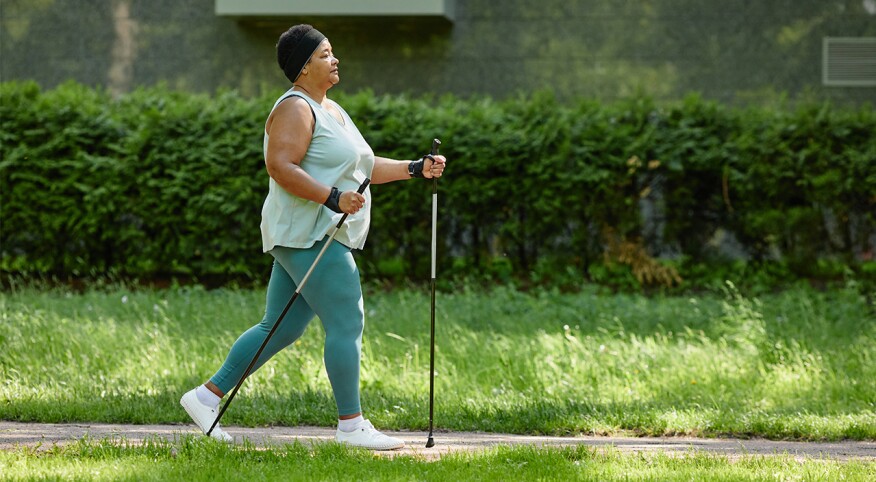The health benefits of walking are no secret. Walking not only improves your overall fitness and cardiac health, but can boost your mood, reduce pain and fatigue, and even lower your risk for cancer and chronic disease. It’s clear why some experts consider it the most underrated form of exercise.
But maybe you’re ready to kick things up a notch. You can turn your walk into a full-body workout and burn more calories with walking poles.
If you think trading walking for running or a high impact cardio class is the only way to ramp up your fitness routine, think again. Walking poles can give you a more intense workout without putting more stress on your joints.
Most folks can burn at least 20 percent more calories walking with poles than without. Walking pole converts are often pleasantly surprised to see a tighter tummy in just a few weeks.
The exercise contracts your abs with every stride—that’s 1800 reps per mile! You’ll start building sleek upper arms and sexy shoulders, too.
Walking poles help you burn extra calories by putting your upper body muscles to work.
Some studies have found that people tend to walk faster when using poles, too. The poles can make it easier for you to take longer and quicker strides, even when climbing a hill. When you’re walking downhill, poles take some of the load off your knees and ankles.
But if you want don’t want to walk faster, that’s fine too. Because the poles help activate your upper body and core along with your lower body, you’re still getting a more complete workout. So walking poles can help you increase the intensity of your walking workout without you increasing your speed.
And even though walking with poles can raise your heart rate more, you probably won’t feel like you’re exerting yourself more than with regular walking.
That means you can walk for your usual length of time or distance at your preferred speed and still get in a better workout.
Walking poles are like a cheat code you should never feel guilty for using!
Other Health Benefits of Walking with Poles
Bisa Myles of Highland, Indiana, started using trekking poles when she was training to hike Mount Kilimanjaro. When preparing for a big hike, Myles often walks eight miles three times a week. She doesn’t track how many calories she burns during a hike and she broke up with her scale long ago. But even without these metrics, Myles knows that trekking poles make a difference.
“I am able to walk faster because it's easier to maintain a certain pace because of the movements in using poles,” she shares. “I like using poles when I'm walking up hills. It helps put less pressure on my knees.”
Myles adds that her arms got stronger, and her posture improved too. “I walk with my back straight,” she says. “I sometimes slouch without the poles.”
Perhaps the best benefit from the trekking poles is something that can’t be measured.
“My confidence increased,” Myles says. Because the poles made it easier to hike up and down hills and because the poles help her keep her balance on rocky trails, she can fearlessly traverse any terrain.
Overall walking or trekking poles can help you walk with better balance and posture and with a more stable gait, which will help decrease your chance of falling during your hike or walking workout.
Two of the most popular pole walking techniques are Exerstriding and Nordic Walking.
With Exerstriding, you hold your arms out like in a handshake and press down on the pole to thrust yourself forward. Nordic walking, which was created in Europe, is based on a cross-country skiing technique. With this method, you’ll keep your poles angled backward. According to VeryWellFit.com, Nordic poles have an attached demi-glove so you can release the pole at the end of the backstroke and have it snap back into your hand.
According to Harvard Health Publishing, research has found that Nordic walking can burn up to 67 percent more calories than regular walking!
Along with helping you burn more calories, walking poles have several other possible health benefits.
By progressing from light to moderate intensity workouts you’re building your cardiovascular fitness and improving your heart health. Walking with poles could benefit your blood pressure too.
Walking with poles can help build upper body strength and reduce upper back and neck pain.
Nordic walking or a similar technique can help improve your posture and your balance.
How to Get Started with Walking Poles
If you want to give walking poles a try, first consider where and how you’ll use them. Fitness or Nordic walking poles are best for walking through your neighborhood or along your favorite paved walking path. If you love to hike through rough and rugged trails, you should opt for trekking poles, which are designed to help you navigate tricky terrains.
When choosing poles you need to check the following suggestions from Today.com:
- Length: Most poles are adjustable, but if you’re very short or very tall, be sure to get a pole that’s right for your height.
- Grip: Some poles have left and right handles, while with other models both handles are the same. Some models also offer a more ergonomic design, which might be the best pick for you if you struggle with arthritis in your hands.
- Hand support: To support your hands, poles may have a ledge, a half or full glove, or a strap. Pressing down on the ledge as you use the poles can help activate your core but try out the different types at your local sporting goods store to see which is best for you.
- Tips: Most walking poles have a rubber tip similar to what you would find on a cane. Some models allow you to change out the tips based on your walking conditions. For example, if you plan to trek along the beach or on the days your neighborhood looks like a winter wonderland, you’ll want a tip that has a basket to help you traverse sand or snow.
To get the most of your new walking workout remember:
Be patient. Walking with poles may take some getting used to, so don’t be hard on yourself if it feels awkward at first. Before trying the poles, you may want to practice moving your arms up to a handshake position while you walk so you can get more comfortable with integrating your upper and lower body. According to Today.com, physical therapist and master trainer for Urban Poling, Jon Schultz recommends that once you’re ready, remember to plant the pole, push down on the handle, and propel to lengthen your stride.
Dress for success. Make sure you wear comfortable clothes that allow for lots of arm movement.
Drink up. Stay hydrated. If you’re walking for less than an hour, drink water in advance. For a longer walks, sip your H2O along the way.
Warm up and cool down. Do a 10-minute warm-up before you start and a 10-minute cool-down after your walk is done. Remember, walking with poles is a workout and will challenge you more than walking alone.
If you’ve been walking regularly and you’re getting bored with your workouts or you’ve been walking to lose weight and you’ve hit a plateau, walking poles could be exactly what you need to bring back the burn.











